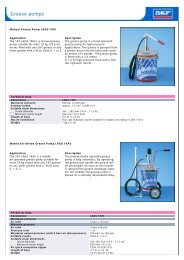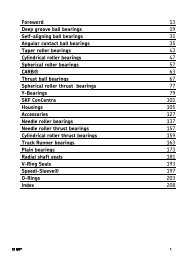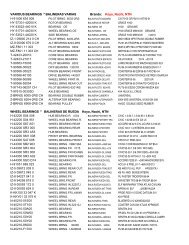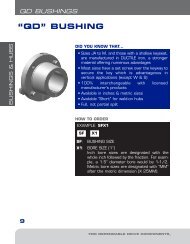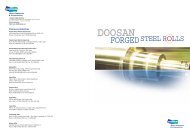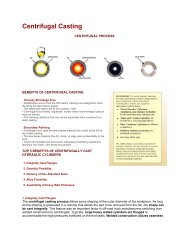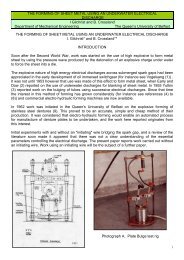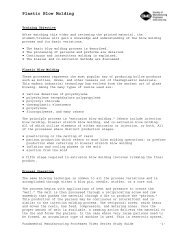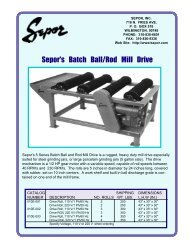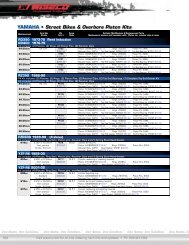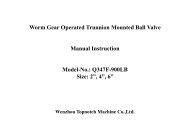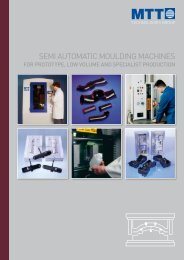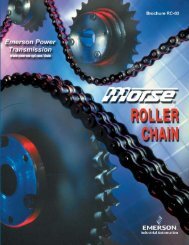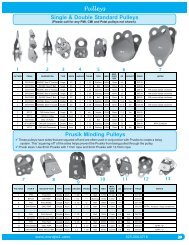HVOF Thermal Spray Coatings as an Alternative to Hard Chrome ...
HVOF Thermal Spray Coatings as an Alternative to Hard Chrome ...
HVOF Thermal Spray Coatings as an Alternative to Hard Chrome ...
You also want an ePaper? Increase the reach of your titles
YUMPU automatically turns print PDFs into web optimized ePapers that Google loves.
<strong>HVOF</strong> <strong>Thermal</strong> <strong>Spray</strong> <strong>Coatings</strong> <strong>as</strong> <strong>an</strong> <strong>Alternative</strong> To<br />
<strong>Hard</strong> <strong>Chrome</strong> Plating on Military <strong>an</strong>d Commercial Aircraft<br />
Bruce D. Sartwell, Naval Research Labora<strong>to</strong>ry, Code 6170, W<strong>as</strong>hing<strong>to</strong>n, DC<br />
Keith Legg, Row<strong>an</strong> Catalyst, Inc., Libertyville, IL<br />
Bruce Bodger, Sulzer-Metco (US) Inc., Westbury, NY<br />
There are currently several ongoing projects designed <strong>to</strong> demonstrate <strong>an</strong>d qualify <strong>HVOF</strong> thermal<br />
spray coatings <strong>as</strong> a functionally superior, cost-effective replacement for hard chrome plating in<br />
m<strong>an</strong>ufacturing <strong>an</strong>d mainten<strong>an</strong>ce operations on military <strong>an</strong>d commercial aircraft. Within the U.S.<br />
Defense Department, the <strong>Hard</strong> <strong>Chrome</strong> <strong>Alternative</strong>s Team (HCAT) is executing several projects<br />
<strong>to</strong> qualify <strong>HVOF</strong> coatings on l<strong>an</strong>ding gear, hydraulic actua<strong>to</strong>rs <strong>an</strong>d propeller components. Joint<br />
Test Pro<strong>to</strong>cols are being prepared that include appropriate coupon tests combined with full-scale<br />
components rig <strong>an</strong>d flight testing. The C<strong>an</strong>adi<strong>an</strong> Government <strong>an</strong>d C<strong>an</strong>adi<strong>an</strong> l<strong>an</strong>ding gear<br />
m<strong>an</strong>ufacturers are partnering with the HCAT <strong>to</strong> execute a similar program. Several commercial<br />
aircraft m<strong>an</strong>ufacturers <strong>an</strong>d airline comp<strong>an</strong>ies are also conducting flight testing of selected aircraft<br />
components. This paper will describe these efforts <strong>an</strong>d provide some results for initial testing.<br />
For more information, contact:<br />
Bruce D. Sartwell<br />
Naval Research Labora<strong>to</strong>ry<br />
Code 6170<br />
W<strong>as</strong>hing<strong>to</strong>n, DC 20375<br />
Phone: (202) 767-0722
FAX: (202) 767-3321<br />
e-mail: sartwell@nrl.navy.mil<br />
Introduction<br />
<strong>Hard</strong> chrome plating is a technique that h<strong>as</strong> been<br />
in commercial production for over 50 years <strong>an</strong>d<br />
which is a critical process <strong>as</strong>sociated with<br />
m<strong>an</strong>ufacturing <strong>an</strong>d mainten<strong>an</strong>ce activities for<br />
commercial <strong>an</strong>d military aircraft. It is used by OEMs<br />
for applying hard, wear-resist<strong>an</strong>t coatings <strong>to</strong> m<strong>an</strong>y<br />
types of aircraft components such <strong>as</strong> l<strong>an</strong>ding gear <strong>an</strong>d<br />
hydraulic actua<strong>to</strong>rs, <strong>an</strong>d it is used by repair depots for<br />
general re-build of worn or corroded components that<br />
have been removed from aircraft during overhaul.<br />
<strong>Hard</strong> chrome plating utilizes chromium in the<br />
hexavalent state (hex-Cr), which is a known<br />
carcinogen. As a result, the Environmental<br />
Protection Agency h<strong>as</strong> issued air emission st<strong>an</strong>dards<br />
for hex-Cr under the so-called MACT St<strong>an</strong>dards, <strong>an</strong>d<br />
the Occupational Safety <strong>an</strong>d Health Administration<br />
(OSHA) h<strong>as</strong> established permissible exposure limits<br />
(PEL) for hex-Cr in the workplace at a level of 100<br />
micrograms/cubic meter. However, recent studies<br />
have indicated that there is a signific<strong>an</strong>tly incre<strong>as</strong>ed<br />
c<strong>an</strong>cer risk at this PEL <strong>an</strong>d therefore there is<br />
consideration of reducing the PEL. Recently, several<br />
public interest groups <strong>an</strong>d unions have filed suit <strong>to</strong><br />
force OSHA <strong>to</strong> issue a proposed new hex-Cr PEL,<br />
but the courts have sided with OSHA, with the result<br />
that OSHA is now expected <strong>to</strong> issue a proposed new<br />
PEL in the Fall of 1999. Preliminary indications are<br />
that OSHA believes the new data supports a lowering<br />
of the PEL <strong>to</strong> a r<strong>an</strong>ge of 0.5 <strong>to</strong> 5 micrograms/cubic<br />
meter. According <strong>to</strong> a spokesm<strong>an</strong> from the surface<br />
finishing industry, a PEL of less th<strong>an</strong> 10<br />
micrograms/cubic meter would subst<strong>an</strong>tially incre<strong>as</strong>e<br />
the cost of chrome plating.<br />
Beyond the concerns of aircraft m<strong>an</strong>ufacturers <strong>an</strong>d<br />
repair facilities related <strong>to</strong> the cost of chrome plating<br />
are also concerns related <strong>to</strong> the in-service<br />
perform<strong>an</strong>ce of chrome plating. In the p<strong>as</strong>t, chrome<br />
h<strong>as</strong> been the best available coating <strong>to</strong> meet the<br />
industry <strong>an</strong>d military requirements. However,<br />
because m<strong>an</strong>y aircraft are being flown considerably<br />
longer th<strong>an</strong> originally <strong>an</strong>ticipated <strong>an</strong>d because of<br />
steadily decre<strong>as</strong>ing funding of mainten<strong>an</strong>ce within<br />
the Defense Department, issues <strong>as</strong>sociated with lifecycle<br />
costs have incre<strong>as</strong>ed in priority. Therefore,<br />
there is a strong incentive <strong>to</strong>wards identifying new<br />
coating technologies that not only eliminate the<br />
environmental <strong>an</strong>d health problems <strong>as</strong>sociated with<br />
hard chrome plating but also demonstrate incre<strong>as</strong>ed<br />
perform<strong>an</strong>ce <strong>as</strong> compared <strong>to</strong> chrome. The<br />
technology that is most promising in terms of<br />
meeting these goals is <strong>HVOF</strong> thermal spraying.<br />
<strong>HVOF</strong> <strong>Thermal</strong> <strong>Spray</strong>ing<br />
High-velocity oxygen-fuel (<strong>HVOF</strong>) thermal<br />
spraying w<strong>as</strong> invented by James A. Browning in<br />
1982. The first commercial systems were available<br />
by the late 1980’s. The process uses <strong>an</strong> internal<br />
combustion (rocket) jet <strong>to</strong> generate supersonic g<strong>as</strong><br />
velocities of approximately 1800 meters/second,<br />
generally in the r<strong>an</strong>ge of Mach 4-5. Combustion<br />
fuels that are mixed with oxygen in the gun include<br />
propylene, acetylene, prop<strong>an</strong>e, hydrogen, <strong>an</strong>d<br />
kerosene. When burned with pure oxygen, these<br />
fuels produce g<strong>as</strong> temperatures greater th<strong>an</strong> 2700<br />
degrees C.<br />
Combustion ignition, g<strong>as</strong> control, <strong>an</strong>d powder feed<br />
are fundamentally simple in <strong>HVOF</strong> spraying systems.<br />
Powder of the material <strong>to</strong> be deposited is fed in<strong>to</strong> the<br />
<strong>HVOF</strong> gun, with feed rates au<strong>to</strong>matically moni<strong>to</strong>red.<br />
Powders deposited using <strong>HVOF</strong> include pure metals,<br />
metal alloys, cermets such <strong>as</strong> tungsten carbide/cobalt,<br />
<strong>an</strong>d certain ceramics <strong>an</strong>d polymers. Generally the<br />
st<strong>an</strong>d-off dist<strong>an</strong>ce between gun <strong>an</strong>d the surface of the<br />
material being coated is usually between 15 <strong>an</strong>d 30<br />
cm. For most <strong>HVOF</strong> coatings, the porosity is less<br />
th<strong>an</strong> 1%, the oxide content, even for fairly reactive<br />
metals, is less th<strong>an</strong> 1%, <strong>an</strong>d the bond strength usually<br />
exceeds 80 MPa (10,000 psi). The inst<strong>an</strong>t<strong>an</strong>eous<br />
deposition rate is approximately 50 micrometers<br />
(0.002”) per minute although in normal operation the<br />
<strong>HVOF</strong> gun is mounted on a robot or other<br />
articulating arm <strong>an</strong>d the component being coated is<br />
also m<strong>an</strong>ipulated (e.g., a cylinder will be rotated). It<br />
therefore generally takes less th<strong>an</strong> 30 minutes <strong>to</strong><br />
deposit a 100-micrometer-thick (0.004”) coating on<strong>to</strong><br />
a 0.5-meter-long, 0.1-meter-diameter cylinder.<br />
Figure 1 is a pho<strong>to</strong>graph of <strong>an</strong> <strong>HVOF</strong> coating being<br />
applied <strong>to</strong> a Boeing 737 nose l<strong>an</strong>ding gear cylinder.<br />
Note the air jets in the upper right h<strong>an</strong>d corner of the<br />
picture which are used <strong>to</strong> maintain a low surface<br />
temperature of the component during processing. In<br />
general, with the use of air jets for cooling, materials<br />
such <strong>as</strong> aluminum c<strong>an</strong> e<strong>as</strong>ily be coated.<br />
At present there are no full-production <strong>HVOF</strong><br />
systems in operation at aircraft m<strong>an</strong>ufacturers,<br />
commercial aircraft mainten<strong>an</strong>ce activities, or
Department of Defense (DOD) aircraft depots, that<br />
are being used <strong>to</strong> deposit coatings on a continuous<br />
b<strong>as</strong>is on<strong>to</strong> components on<strong>to</strong> which hard chrome h<strong>as</strong><br />
been used in the p<strong>as</strong>t. There are some <strong>HVOF</strong><br />
systems in operation at DOD aircraft depots that are<br />
being used for selected chrome replacement,<br />
however. As <strong>an</strong> example in 1993, the Naval Aviation<br />
Depot in Jacksonville, Florida, procured a Metco<br />
Figure 1. <strong>HVOF</strong> thermal spraying of WC/Co<br />
coating on<strong>to</strong> a nose l<strong>an</strong>ding gear cylinder from a<br />
Boeing 737. The cylinder is approximately 0.6 m<br />
long.<br />
Diamond Jet <strong>HVOF</strong> system <strong>to</strong> facilitate replacement<br />
of chrome plating on J52 engine oil system<br />
components that had worn <strong>to</strong> the point that chrome<br />
plating w<strong>as</strong> no longer a viable coating because of<br />
thickness <strong>an</strong>d perform<strong>an</strong>ce limitations. Twelve<br />
components were successfully demonstrated <strong>as</strong><br />
c<strong>an</strong>didates for <strong>HVOF</strong> in 1994. Since then, additional<br />
components on the F404 <strong>an</strong>d TF34 engines have been<br />
repaired using <strong>HVOF</strong>.<br />
Current Efforts in Defense Department<br />
A project entitled, “Tri-Service Demonstration-<br />
Validation of Chromium Electroplating<br />
Replacements,” under the principal sponsorship of<br />
the DOD Environmental Security Technology<br />
Certification Program (ESTCP), w<strong>as</strong> initiated in 1996<br />
<strong>to</strong> conduct studies <strong>to</strong> qualify <strong>an</strong>d insert <strong>HVOF</strong><br />
technology in<strong>to</strong> DOD aircraft mainten<strong>an</strong>ce depots.<br />
Among the original particip<strong>an</strong>ts in the project were<br />
five demonstration sites: Cherry Point <strong>an</strong>d<br />
Jacksonville Naval Aviation Depots, Ogden <strong>an</strong>d<br />
Sacramen<strong>to</strong> Air Logistics Centers, <strong>an</strong>d Corpus Christi<br />
Army Depot. Other original particip<strong>an</strong>ts included<br />
the Naval <strong>an</strong>d Air Force Research Labora<strong>to</strong>ries,<br />
Northwestern University, GE Aircraft Engines, <strong>an</strong>d<br />
Metcut Research, Inc. The project team, designated<br />
the <strong>Hard</strong> <strong>Chrome</strong> <strong>Alternative</strong>s Team (HCAT),<br />
developed a generic test pro<strong>to</strong>col <strong>an</strong>d executed a<br />
signific<strong>an</strong>t amount of fatigue, corrosion, <strong>an</strong>d wear<br />
testing on 4340 steel, 7075 aluminum alloy, <strong>an</strong>d<br />
PH13-8Mo stainless steel substrate materials coated<br />
with either WC/Co (83%/17%) or Tribaloy 400 (a<br />
Co-Mo-Cr alloy) coatings deposited by <strong>HVOF</strong>.<br />
More recently, the HCAT h<strong>as</strong> formed a<br />
partnership with the DOD Joint Acquisition <strong>an</strong>d<br />
Sustainment Pollution Prevention Activity<br />
(JASPPA), <strong>an</strong> org<strong>an</strong>ization chartered by the Joint<br />
Logistics Comm<strong>an</strong>ders that represents a merger of<br />
the previous Joint Group on Acquisition Pollution<br />
Prevention (JG-APP) <strong>an</strong>d Joint Depot Environmental<br />
P<strong>an</strong>el (JDEP). Previously the JG-APP focused on<br />
inserting new non-polluting technologies in<br />
m<strong>an</strong>ufacturers of DOD weapons systems where<strong>as</strong> the<br />
JDEP examined new technologies for DOD<br />
mainten<strong>an</strong>ce depots. The objective of the new<br />
org<strong>an</strong>ization is <strong>to</strong> identify projects that c<strong>an</strong> drive<br />
down DOD <strong>to</strong>tal ownership costs, from production<br />
through sustainment <strong>to</strong> disposal. It is intended that<br />
JASPPA only initiate projects where the users,<br />
depots, program offices, <strong>an</strong>d m<strong>an</strong>ufacturers all agree<br />
there will be cost benefits <strong>an</strong>d agree <strong>to</strong> jointly fund<br />
efforts <strong>to</strong> reduce hazardous materials usage.<br />
The HCAT/JASPPA effort on hard chrome<br />
replacement using <strong>HVOF</strong> represents the first of these<br />
projects. Where<strong>as</strong> HCAT had initially hoped for a<br />
complete across-the-board qualification of <strong>HVOF</strong><br />
coatings on all types of aircraft components, it<br />
became apparent that this w<strong>as</strong> not fe<strong>as</strong>ible <strong>an</strong>d that,<br />
working with JASPPA, a more logical approach w<strong>as</strong><br />
<strong>to</strong> execute projects qualifying <strong>HVOF</strong> coatings on<br />
types of aircraft components. As a result, individual<br />
projects on l<strong>an</strong>ding gear, hydraulic actua<strong>to</strong>rs,<br />
propeller hubs, <strong>an</strong>d rotary wing aircraft components<br />
(such <strong>as</strong> helicopter ro<strong>to</strong>r heads) have been initiated.<br />
The l<strong>an</strong>ding gear effort is the most adv<strong>an</strong>ced, with a<br />
Joint Test Pro<strong>to</strong>col (JTP) nearing completion. The<br />
JTP is a comprehensive document that describes in<br />
detail coupon, rig, <strong>an</strong>d flight testing of specific types
of <strong>HVOF</strong> coatings. For the l<strong>an</strong>ding gear coupon<br />
testing, three types of b<strong>as</strong>e materials will be used,<br />
4340, 300M, <strong>an</strong>d Aermet 100 steels, <strong>an</strong>d one type of<br />
<strong>HVOF</strong> coating will be evaluated, 83WC/17Co, in<br />
comparison <strong>to</strong> hard chrome. The JTP describes in<br />
detail how the substrate materials are prepared, how<br />
the coatings are deposited, <strong>an</strong>d how the coatings are<br />
ground for testing. Extensive fatigue, corrosion,<br />
sliding wear, abr<strong>as</strong>ive wear, <strong>an</strong>d hydrogen<br />
embrittlement tests will be conducted. Rig tests are<br />
pl<strong>an</strong>ned for the main l<strong>an</strong>ding gear of the F18-E/F<br />
fighter in which several support components that are<br />
currently chrome plated will have the WC/Co <strong>HVOF</strong><br />
coatings applied <strong>to</strong> them. Finally, actual flight<br />
testing on a <strong>HVOF</strong>-coated main l<strong>an</strong>ding gear cylinder<br />
for the P3 aircraft will be conducted. Results of all of<br />
the testing will be provided <strong>to</strong> appropriate<br />
stakeholders in order <strong>to</strong> obtain approval <strong>to</strong> apply<br />
<strong>HVOF</strong> coatings in production <strong>to</strong> l<strong>an</strong>ding gear<br />
components.<br />
Results of Previous Testing<br />
As mentioned above, the HCAT had conducted a<br />
signific<strong>an</strong>t amount of testing on <strong>HVOF</strong> coatings on<br />
several different materials. Only a brief overview<br />
will be provided here, with considerably more<br />
detailed information presented in reference #1.<br />
Fatigue Tests<br />
Axial fatigue studies were conducted on 4340<br />
steel, 7075 aluminum alloy, <strong>an</strong>d PH13-8Mo stainless<br />
steel coupons which had been coated with hard<br />
chrome, 83WC/17Co, <strong>an</strong>d Tribaloy 400 <strong>HVOF</strong><br />
coatings. The specimen geometry w<strong>as</strong> designated <strong>as</strong><br />
“smooth-bar” in which the “necked-down” region<br />
w<strong>as</strong> 0.63-cm-diameter over a length of 1.9 cm. Both<br />
low-cycle-fatigue (LCF) <strong>an</strong>d high-cycle-fatigue<br />
(HCF) tests were conducted <strong>an</strong>d S/N curves were<br />
generated over a wide r<strong>an</strong>ge of maximum load<br />
conditions. Figure 2 shows the data for the uncoated<br />
4340 specimens <strong>an</strong>d the three coated 4340<br />
specimens. The data for the hard-chrome-coated<br />
specimens indicates a subst<strong>an</strong>tial loss of fatigue<br />
strength. The data for the <strong>HVOF</strong> coatings fell within<br />
the statistical uncertainty of the uncoated specimens,<br />
indicating essentially no loss of fatigue strength.<br />
Subsequent <strong>to</strong> failure, the specimens were examined<br />
for failure location. The hard chrome plate indicated<br />
18 failures under the coating <strong>an</strong>d 2 failures outside<br />
the coating. The <strong>HVOF</strong> Tribaloy 400 gave exactly<br />
the opposite, 18 failures outside the coating <strong>an</strong>d only<br />
2 failures under the coating. The <strong>HVOF</strong> WC/Co had<br />
10 failures each under the coating <strong>an</strong>d outside the<br />
coating. The signific<strong>an</strong>ce of failure location is that<br />
those failures outside the coated area are parent metal<br />
failures unaffected by the coating or coating process.<br />
Thus, one clearly concludes the hard chrome<br />
coating/process usually caused failures (<strong>an</strong>d at<br />
reduced strengths) while the <strong>HVOF</strong> Tribaloy 400<br />
coating/process had no effect. Also, the <strong>HVOF</strong><br />
WC/Co coating/process probably had little effect<br />
since the 50% of failures within the coated area were<br />
at virtually the same fatigue strengths <strong>an</strong>d lives <strong>as</strong><br />
uncoated 4340 steel.<br />
Figure 2. S/N data for smooth bar uncoated 4340<br />
steel specimens <strong>an</strong>d 4340 specimens coated with<br />
hard-chrome, <strong>HVOF</strong> WC/17%Co, <strong>an</strong>d <strong>HVOF</strong><br />
Tribaloy 400.<br />
Corrosion Studies<br />
Extensive corrosion tests of the same substrate<br />
materials <strong>an</strong>d same coatings were conducted using<br />
the pro<strong>to</strong>cols of the ASTM B117 salt fog tests <strong>an</strong>d<br />
GM9540P/B cyclic corrosion test. At le<strong>as</strong>t five<br />
specimens for each coating/substrate combination<br />
were evaluated. Pho<strong>to</strong>graphs were taken prior <strong>to</strong><br />
exposure <strong>to</strong> document the surface <strong>an</strong>d the samples<br />
were visually examined at 125-hour intervals <strong>an</strong>d<br />
given <strong>an</strong> appear<strong>an</strong>ce r<strong>an</strong>king, b<strong>as</strong>ed on ASTM<br />
pro<strong>to</strong>cols. The r<strong>an</strong>kings r<strong>an</strong>ged from 10, representing<br />
a pristine surface, <strong>to</strong> 0, representing complete
corrosion of the surface. The <strong>to</strong>tal duration of the<br />
tests were 1000 hours.<br />
Figure 3 shows the appear<strong>an</strong>ce r<strong>an</strong>kings <strong>as</strong> a<br />
function of time for the 4340 steel substrates with the<br />
hard chrome <strong>an</strong>d <strong>HVOF</strong> coatings subjected <strong>to</strong> the<br />
B117 test. B<strong>as</strong>ed on these r<strong>an</strong>kings, the <strong>HVOF</strong><br />
coatings demonstrated incre<strong>as</strong>ed corrosion resist<strong>an</strong>ce<br />
over the chrome, but in fact it w<strong>as</strong> discovered that<br />
there were blistered are<strong>as</strong> on the <strong>HVOF</strong> coatings<br />
which, when removed, showed that overall the extent<br />
of corrosion w<strong>as</strong> the same for the <strong>HVOF</strong> coatings <strong>as</strong><br />
for the hard chrome. Therefore, it w<strong>as</strong> concluded that<br />
all coatings performed approximately equally in the<br />
B117 test.<br />
R<strong>an</strong>king<br />
10<br />
8<br />
6<br />
4<br />
2<br />
0<br />
4340 Steel Substrate<br />
ASTM B117<br />
<strong>Chrome</strong><br />
T400 4340<br />
WC-Co 4340<br />
Cr 4340<br />
0 250 500 750 1000 1250<br />
Hours<br />
WC-Co<br />
T400<br />
Figure 3. Appear<strong>an</strong>ce r<strong>an</strong>kings for various<br />
coatings on 4340 steel specimens subjected <strong>to</strong> the<br />
B117 salt fog test<br />
The GM cyclic corrosion test is generally less<br />
aggressive th<strong>an</strong> the B117 test <strong>an</strong>d this w<strong>as</strong> found <strong>to</strong><br />
be true for the hard chrome <strong>an</strong>d <strong>HVOF</strong> coatings.<br />
Figure 4 shows the results of the GM testing of the<br />
coatings <strong>as</strong> a function of time, <strong>an</strong>d again the<br />
perform<strong>an</strong>ce of the three coatings w<strong>as</strong> comparable.<br />
10<br />
8<br />
6<br />
4<br />
2<br />
0<br />
Appear<strong>an</strong>ce R<strong>an</strong>king<br />
10<br />
8<br />
6<br />
4<br />
2<br />
0<br />
T400<br />
Cr<br />
4340 Steel Substrate<br />
GM9540P/B<br />
WC-Co<br />
T400<br />
Cr<br />
WC-Co<br />
0 500 1000 1500<br />
Hours<br />
2000 2500<br />
Figure 4. Appear<strong>an</strong>ce r<strong>an</strong>kings for various<br />
coatings on 4340 steel specimens subjected <strong>to</strong> GM<br />
cyclic corrosion test.<br />
Hydraulic Actua<strong>to</strong>r Simulation Test<br />
The aerospace industry h<strong>as</strong> used chrome-plated<br />
hydraulic actua<strong>to</strong>r rods for decades, <strong>an</strong>d generally<br />
they have performed satisfac<strong>to</strong>rily. However, for the<br />
re<strong>as</strong>ons given in the Introduction, several types of<br />
coatings, including <strong>HVOF</strong>, are being investigated <strong>as</strong><br />
<strong>an</strong> alternative <strong>to</strong> the chrome. Greene, Tweed & Co.,<br />
in cooperation with the Air Force <strong>an</strong>d HCAT,<br />
conducted tests on simulated actua<strong>to</strong>r rods that<br />
received the following coatings:<br />
1. St<strong>an</strong>dard dense hard chrome<br />
2. <strong>HVOF</strong> 88WC/12Co applied by Sulzer Metco<br />
3. D-Gun 88WC/12Co applied by Praxair Surface<br />
Technologies<br />
4. Takada Ni-W-SiC (48/48/4), <strong>an</strong> electrochemical<br />
process applied by Delta Pollution Control<br />
5. Diamonex, <strong>an</strong> amorphous carbon coating applied<br />
by physical vapor deposition.<br />
Two seal types were used <strong>as</strong> a reference for<br />
evaluation of the c<strong>an</strong>didate rod coatings. The GTC<br />
Ener-Cap which is a capped “slipper” type seal <strong>an</strong>d<br />
the GTC AGT ring (T-seal) which is <strong>an</strong> el<strong>as</strong><strong>to</strong>meric<br />
type seal. These two seals represent the two broad<br />
categories of seal types used in general aircraft<br />
hydraulic systems. The labora<strong>to</strong>ry evaluation w<strong>as</strong><br />
conducted by Greene, Tweed in order <strong>to</strong> <strong>as</strong>sess the<br />
perform<strong>an</strong>ce of individual rod <strong>an</strong>d seal combinations.<br />
Each seal <strong>an</strong>d rod w<strong>as</strong> tested for 2 million cycles.<br />
The load <strong>an</strong>d stroke “duty” profile w<strong>as</strong> b<strong>as</strong>ed on Air<br />
Force data 2 which simulated stroke amplitudes,<br />
frequencies <strong>an</strong>d operating times for fighter type<br />
aircraft. Prior <strong>to</strong> <strong>an</strong>d after each test, all seal, rod <strong>an</strong>d
gl<strong>an</strong>d hardware critical dimensions were me<strong>as</strong>ured.<br />
Leakage of hydraulic fluid w<strong>as</strong> me<strong>as</strong>ured after each<br />
ph<strong>as</strong>e of the testing. Figure 5 shows the <strong>to</strong>tal leakage<br />
for the 2 million cycles in grams. The leakage of all<br />
c<strong>an</strong>didate rod coatings is subst<strong>an</strong>tially lower th<strong>an</strong> that<br />
of the chrome. The seals were in excellent condition<br />
after the test with the <strong>HVOF</strong>, D-gun, <strong>an</strong>d Diamonex<br />
coatings, with some seal degradation observed with<br />
the Takada <strong>an</strong>d chrome. The <strong>HVOF</strong> <strong>an</strong>d D-gun rod<br />
coatings were in excellent condition after the test,<br />
with the Diamonex showing very minor degradation<br />
followed by moderate degradation of the Takada rods<br />
<strong>an</strong>d relatively higher degradation of the chrome rods.<br />
These were only considered <strong>to</strong> be screening tests.<br />
The Air Force estimates that 10 million cycles would<br />
160<br />
140<br />
120<br />
100<br />
80<br />
60<br />
40<br />
20<br />
0<br />
T-Seal<br />
Ener-cap<br />
be equivalent <strong>to</strong> 1000 flight hours. Therefore, a 3000<br />
hour time-between-overhaul test would require 30<br />
million test cycles. Such tests are currently in<br />
progress, but it is apparent from the screening tests<br />
that the <strong>HVOF</strong> coatings should outperform hard<br />
chrome on hydraulic actua<strong>to</strong>r rods.<br />
Current Efforts in Commercial Aircraft<br />
Sec<strong>to</strong>r<br />
There are a number of efforts within the<br />
commercial aircraft sec<strong>to</strong>r directed at replacing hard<br />
chrome with <strong>HVOF</strong> coatings on l<strong>an</strong>ding gear.<br />
Boeing Commercial Aircraft Group h<strong>as</strong> been<br />
particularly aggressive in working with several<br />
different airlines on flight testing <strong>HVOF</strong> coatings on<br />
<strong>HVOF</strong> D-GUN TAKADA DIAMONEX CHROME<br />
Figure 5. Leakage of hydraulic fluid, expressed in grams, for various coated rods against two seal types<br />
different types of l<strong>an</strong>ding gear components. The<br />
strategy is these c<strong>as</strong>es is <strong>to</strong> conduct the necessary<br />
flight testing <strong>to</strong> qualify the <strong>HVOF</strong> coatings on a<br />
component-by-component b<strong>as</strong>is. Table 1 provides a<br />
summary of the flight tests that are currently in<br />
progress.<br />
Table 1. Flight tests in progress <strong>to</strong> evaluate <strong>HVOF</strong><br />
coatings <strong>as</strong> chrome replacement.<br />
AL Model Part Coating DIS<br />
DLH 737 NLG-IC WC/Co 1-96<br />
DAL 737 NLG-IC WC/CoCr 12-97<br />
BAB 757 NLG-IC WC/CoCr 2-98<br />
DAL 757 Axle WC/CoCr 2-98<br />
DAL 757 Axle WC/CoCr 2-98<br />
DAL 767 Axle WC/CoCr 3-98<br />
DAL 767 Axle WC/CoCr 5-98<br />
Legend: AL = airline
DIS = date in service<br />
DLH = Lufth<strong>an</strong>sa<br />
NLG = nose l<strong>an</strong>ding gear<br />
IC = inner cylinder<br />
DAL = Delta Airlines<br />
BAB = British Airways<br />
Inspections have been conducted on most of these<br />
components with the result that the <strong>HVOF</strong><br />
components have performed satisfac<strong>to</strong>rily with no<br />
failures <strong>an</strong>d no rejections.<br />
Another <strong>as</strong>pect <strong>to</strong> the qualification of <strong>HVOF</strong><br />
coatings on commercial aircraft l<strong>an</strong>ding gear h<strong>as</strong><br />
been the issu<strong>an</strong>ce of <strong>an</strong> Aerospace Material<br />
Specification related <strong>to</strong> application of <strong>HVOF</strong> thermal<br />
spray coatings. AMS 2447A w<strong>as</strong> issued in July 1998<br />
<strong>an</strong>d provided engineering requirements for applying<br />
the <strong>HVOF</strong> coatings, including specifications for the<br />
10.3<br />
14.5<br />
10.3<br />
53<br />
6 8 6<br />
0.5<br />
8 24<br />
0.3 2<br />
1.5<br />
0.3 2<br />
1 1.5<br />
0.5 1<br />
2<br />
12<br />
0.5<br />
2<br />
properties of the coatings. Copies of this<br />
specification c<strong>an</strong> be obtained from SAE International<br />
at 724-776-4970.<br />
The utilization of <strong>HVOF</strong> coatings in place of<br />
chrome is expected not only <strong>to</strong> incre<strong>as</strong>e perform<strong>an</strong>ce<br />
of the component on<strong>to</strong> which the coating is applied,<br />
but also <strong>to</strong> reduce turnaround times <strong>as</strong>sociated with<br />
performing the <strong>to</strong>tal mainten<strong>an</strong>ce on the component.<br />
Sulzer Metco h<strong>as</strong> done a study on personnel hours<br />
<strong>an</strong>d <strong>to</strong>tal process hours <strong>as</strong>sociated with repairing a<br />
Boeing 737 nose l<strong>an</strong>ding gear inner cylinder pis<strong>to</strong>n.<br />
The results of that study are presented <strong>as</strong> figure 6,<br />
which indicate that the <strong>to</strong>tal labor hours c<strong>an</strong> be<br />
reduced from 14.5 <strong>to</strong> 10.3 <strong>an</strong>d, more signific<strong>an</strong>tly,<br />
the <strong>to</strong>tal process hours c<strong>an</strong> be reduced from 53 <strong>to</strong><br />
10.3, principally because of the reduced coating time<br />
<strong>an</strong>d the elimination of the post-coating bakeout cycle.<br />
hvof<br />
m<strong>an</strong><br />
hours<br />
cr plate<br />
m<strong>an</strong><br />
hours<br />
Figure 6. Personnel <strong>an</strong>d process hours <strong>as</strong>sociated with repairing a Boeing 737 nose l<strong>an</strong>ding gear inner<br />
cylinder pis<strong>to</strong>n using chrome plating <strong>an</strong>d <strong>HVOF</strong> thermal spray coatings.<br />
1<br />
2<br />
6<br />
hvof<br />
process<br />
hours<br />
cr plate<br />
process<br />
hours<br />
60<br />
40<br />
20<br />
0
Therefore, it is apparent that application of <strong>HVOF</strong><br />
coatings c<strong>an</strong> reduce mainten<strong>an</strong>ce time <strong>an</strong>d thereby<br />
reduce overall mainten<strong>an</strong>ce costs which also will lead<br />
<strong>to</strong> a reduced requirement for maintaining a spare<br />
parts inven<strong>to</strong>ry.<br />
Summary<br />
There are currently ongoing programs both in the<br />
Department of Defense <strong>an</strong>d in the commercial<br />
aircraft sec<strong>to</strong>r <strong>to</strong> qualify <strong>HVOF</strong> thermal spray<br />
coatings <strong>as</strong> a viable replacement for hard chrome<br />
plating. Results have generally shown that the<br />
perform<strong>an</strong>ce of the <strong>HVOF</strong> coatings should exceed<br />
that of hard chrome, that the <strong>HVOF</strong> coating process<br />
does not produce <strong>an</strong>y hazardous w<strong>as</strong>te, <strong>an</strong>d that<br />
turnaround times for mainten<strong>an</strong>ce should be<br />
subst<strong>an</strong>tially reduced. A final determination of the<br />
efficacy of <strong>HVOF</strong> coatings will have <strong>to</strong> await<br />
specific qualification in production <strong>an</strong>d long-term<br />
usage data.<br />
References<br />
1. B. D. Sartwell, P. M. Natish<strong>an</strong>, I. L. Singer, K. O.<br />
Legg, J. D. Schell, <strong>an</strong>d J. P. Sauer, Proc. AESF<br />
Aerospace Plating Forum, p. 235, (1997)<br />
2. Aerospace Sealing Technology, Vol. 11, No. 7,<br />
(1998)



